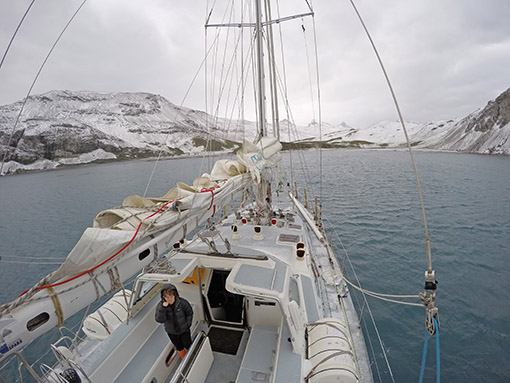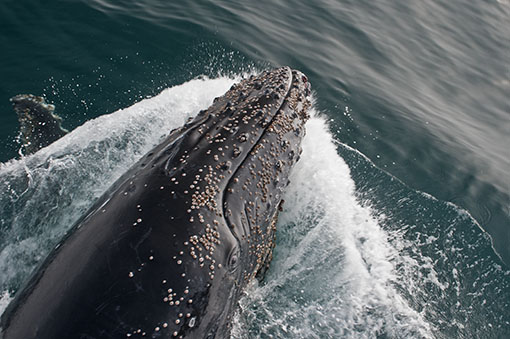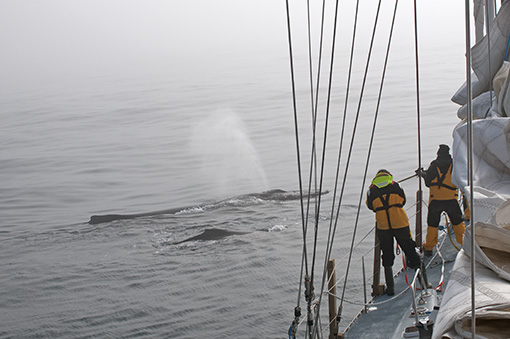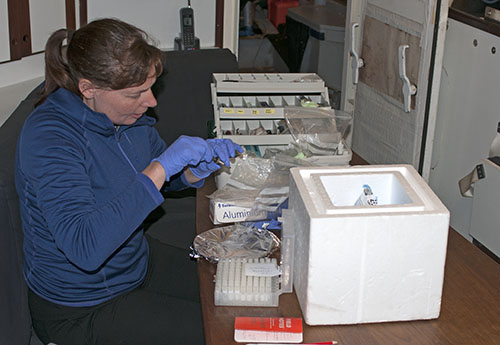
After a comfortable night in the bay at Godthul, we waited until mid-morning for the wind to die down. Soon after leaving the anchorage Susie and Russell deployed a sonobuoy and quite quickly picked up probable Southern right whale vocalisations. I had the chance to put on the headphones and hear the whale. It is hard to describe the sound, something like a low gulp from the bottom of a deep well. Although brief and faint, listening to the whale hidden somewhere down below was an amazing and somehow emotional experience. Suddenly I could imagine life in the ocean depths more clearly, the whales communicating with each other across miles of darkness, reliant on sound to find food and each other. The intrusion of anthropomorphic noise into this little known world was brought home by the presence of a seismic survey vessel operating around South Georgia during our expedition. Every 10 seconds a sound like rumbling thunder came through the headphones and showed up as a broad frequency signal on the computer screen, even when the ship was over 100 miles from our position.

We had been heading northwest, towards the area where we saw whales on the way in, and a slight course alteration put us on the bearing for the whale’s location calculated from the sonobuoy information. About half an hour later blows were spotted and for the next few hours we were on the trail of several Southern right whales. Once again, the whales were elusive and made long dives. With 20 – 25 knot winds and fairly rough seas, we had little success in approaching them.
The forecast was for light winds overnight and the following morning so we stayed out, about 10 miles offshore. We were treated to the rare sight of South Georgia completely cloud free, spread along the horizon, and a spectacular sunset behind the island. We sailed slowly through the night, enjoying the clear, starry sky as the sea calmed down a bit. First thing in the morning we found two Southern right whales, one with a long wound on its back. The scientists believed this to be caused either by a boat strike or by an entanglement, perhaps with fishing gear. We spent several hours with the whales, taking photo ID shots and initially attempting to obtain biopsy samples. Emma and Matt were in position on the foredeck for much of the time but soon the wind was increasing again and conditions deteriorated fast. With strong winds forecast for the next 2 days we returned to Grytviken for shelter.
Our hopes were focussed on an approaching 36-hour weather gap, the longest period of light winds we had yet seen. After an early dinner, we left Grytviken in the evening and headed out towards our whale area. It was another beautiful night, cold and clear with variable winds under 10 knots and a gently rolling sea – very promising! 2 sonobuoys were deployed overnight, detecting the seemingly ever present blue whales but no Southern rights. Visual observations began at first light but were short-lived – by 8 a.m we were shrouded in thick fog with visibility under 300m. To everyone’s intense disappointment the fog stayed with us for the whole day, so despite otherwise near perfect conditions, our efforts were somewhat curtailed by the weather.
Jen had the position of a krill patch about 20 miles northwest and we decided to head towards it in the hopes that the fog would clear en route. About half way there, by chance we came across hundreds of fur seals and penguins, churning the surface of the water. We guessed that they were feeding and stopped the boat to watch them. Looking over the side we saw krill in the water. With very limited visibility, we shut down the engine to drift, feeling certain that there would be whales around and that we would have more chance of hearing them than seeing them.

Just a few minutes later we heard blows and then saw the dark backs of two whales on the edge of sightability. They were a humpback mother and calf, another species of interest to this project. We fired up the engine again and manoeuvred to keep them in sight while Matt and Emma prepared their biopsy equipment. For the first time it was calm enough for Amy to consider tagging so she also got ready on the foredeck. It would have been difficult to keep track of the whales in the fog, but the calf seemed fascinated by the boat. It approached to within a few meters numerous times and the mother seemed unconcerned.
With everyone ready and Mat on the helm, we began the tricky process of approaching the whales closely enough for the researchers to work. While within 30m is good enough for biopsies, Amy needs to be within about 5m in order to correctly place a satellite tracking tag. Despite the whales’ apparent interest in the boat, it was still difficult to get into the optimum position. Both whales were moving around us, often disappearing below the surface for minutes at a time, and it was important not to get between the mother and her calf. After about an hour, we felt we had spent long enough with the pair and decided to give up the tagging attempt. Emma took a biopsy sample from the mother and we watched the whales vanish into the fog.

We spent another night out at sea and for much of the time we shut down the engine and drifted on a gentle swell, shrouded in a damp cocoon of fog. I came on watch at 0600 to a grey, cold day. Almost at once the wind began to pick up and as the fog cleared the rain began. The sea soon built into a seething mass of whitecaps and in a now familiar pattern, several Southern right blows were seen. Despite the weather Matt got into position on the foredeck. We spent several hours tracking a number of whales and trying to approach them. When steering downwind, conditions were manageable, but the minute we turned into the wind the foredeck was awash and the driving rain half blinded us. Amy got several good photo ID shots but Matt had to admit defeat. Feeling as if we had had a full day’s worth of action we anchored in Prince Olav Harbour around 11 a.m, in time for a late breakfast.
The wind increased throughout the day with wild ‘willywaws’ (intense wind gusts generated by local topography) buffeting the boat. The record maximum seen overnight was 61 knots. By early afternoon the next day conditions had eased enough to venture out and across the Bay of Isles to Rosita Harbour, hugging the shore for shelter. With a southwest wind of over 25 knots and frequent rain squalls, maintaining visual observations was not particularly pleasant. Although we saw no whales, we were rewarded with glimpses of wandering albatross on their nests on the islands and a great view of the huge king penguin colony at Salisbury Plains, estimated at around 60 000 birds.
We were up early the next day and found snow on the deck. The wind was strong but behind us for a long day sailing back to Grytviken. This was our last chance to take samples, as these had to be left at the BAS research station in South Georgia for shipment back to the UK. Once again conditions were challenging with big seas. Amy managed to photograph a number of Southern right whales and Matt obtained another biopsy, so it was a successful day.

The skin samples will be used in various ways to obtain detailed information about the whales’ feeding habits, origin and hopefully age. Examining stable isotopes of carbon, which vary across latitude, and nitrogen, which vary across the food chain, can help identify where the whales have been feeding and what they have been eating. DNA analysis will be used to identify individual whales and can also reveal relationships between whales. One of this project’s objectives is to ascertain which Southern right whale populations the whales using South Georgia waters are from. Years of research on Argentinian and South African breeding grounds mean there are extensive data sets available for comparison. Emma is also planning to develop a method for ageing Southern right whales in the South Atlantic, using molecular biomarkers.
Our final few days in South Georgia were spent in Grytviken, preparing for the voyage back to the Falkland Islands, while another gale blew itself out. Equipment was sorted and stowed, the diesel tanks were filled and the precious biopsy samples were carefully transferred from the container of liquid nitrogen on the aft deck to the freezer on shore. We all took the chance to stretch our legs and say goodbye to the fur seal pups, which have entertained us at the dock. Amy processed the photo ID shots and estimated that we have documented 21 individual Southern right whales, a great start to this 2-year project. We were all sorry to be leaving South Georgia and can’t wait to return next year…
Kirstin

Sorry, comments are closed for this post.